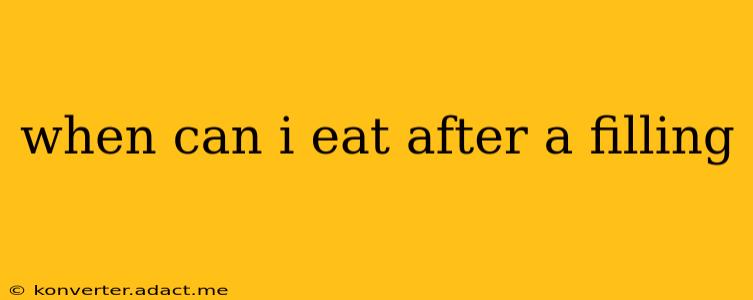Getting a dental filling is a common procedure, but knowing when you can comfortably eat afterward is a crucial question. The answer isn't a simple one-size-fits-all, and depends on several factors, including the size and location of the filling, your individual healing process, and your dentist's specific instructions. Let's delve into the details.
How Long Should I Wait to Eat After a Filling?
Generally, your dentist will advise you to wait at least a couple of hours after getting a filling before eating anything. This allows the anesthetic to wear off completely and the filling material to begin setting properly. Rushing the process could dislodge the filling or cause discomfort. However, this is a general guideline; your dentist's post-operative instructions are paramount. Always prioritize their advice tailored to your specific situation.
What Can I Eat After a Filling?
During the initial hours after the procedure, it’s best to stick to soft foods. Think things like:
- Yogurt: A smooth, cool option that's easy to swallow.
- Applesauce: Provides nutrients without putting pressure on the filling.
- Mashed potatoes: Gentle on the teeth and gums.
- Oatmeal: A warm and comforting choice.
- Scrambled eggs: Easy to chew and digest.
- Soups (broth-based): Nourishing and avoids putting stress on the affected tooth.
Avoid hard, crunchy, or sticky foods for at least 24 hours, or as long as your dentist recommends. These can potentially dislodge the filling or irritate the area.
What Foods Should I Avoid After a Filling?
For the first 24-48 hours (or as instructed by your dentist), steer clear of these foods:
- Hard candies: These could crack or damage the newly placed filling.
- Nuts: Their hardness can dislodge the filling.
- Chewy candies: The stickiness can pull at the filling.
- Popcorn: The kernels can get stuck and cause irritation.
- Tough meats: Require excessive chewing, putting pressure on the filling.
- Ice: Extremely hard and could potentially damage the filling.
Can I Eat Right Away After a Filling with Local Anesthesia?
No, even with local anesthesia, you should still wait. While the numbness may wear off within a few hours, the filling still needs time to set properly. Eating too soon could compromise the filling's longevity and potentially cause pain or discomfort later on.
What if My Filling Feels Loose After Eating?
If you experience any discomfort or notice your filling feels loose after eating, contact your dentist immediately. This is not normal and requires professional attention.
What if I Bit Down on Something Hard After Getting a Filling?
If you accidentally bit down on something hard despite the waiting period, contact your dentist as soon as possible. They can assess the situation and determine if any damage occurred.
How Long Does It Take for a Filling to Fully Set?
The setting time for a filling varies depending on the type of material used. However, it's generally recommended to follow your dentist's dietary recommendations for at least 24-48 hours to allow for proper hardening and bonding.
Remember: The information provided here is for general guidance only. Always follow your dentist's specific post-operative instructions, as they are tailored to your individual case and the type of filling used. If you have any concerns, don't hesitate to contact your dental professional.
